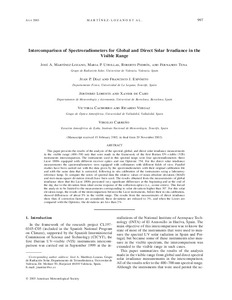Por favor, use este identificador para citar o enlazar este ítem:
http://hdl.handle.net/20.500.11765/2300
Intercomparison of spectroradiometers for global and direct solar irradiance in the visible range
Registro completo de metadatos
| Campo DC | Valor | Lengua/Idioma |
|---|---|---|
| dc.contributor.author | Martínez Lozano, José Antonio | es_ES |
| dc.contributor.author | Utrillas, María Pilar | es_ES |
| dc.contributor.author | Pedrós, Roberto | es_ES |
| dc.contributor.author | Tena Sangüesa, Fernando | es_ES |
| dc.contributor.author | Díaz González, Juan Pedro | es_ES |
| dc.contributor.author | Expósito González, Francisco Javier | es_ES |
| dc.contributor.author | Lorente, Jerónimo | es_ES |
| dc.contributor.author | Cabo, Xavier de | es_ES |
| dc.contributor.author | Cachorro, Victoria E. | es_ES |
| dc.contributor.author | Vergaz, Ricardo | es_ES |
| dc.contributor.author | Carreño Corbella, Virgilio | es_ES |
| dc.date.accessioned | 2016-05-05T08:02:00Z | - |
| dc.date.available | 2016-05-05T08:02:00Z | - |
| dc.date.issued | 2003 | - |
| dc.identifier.citation | Journal of Atmospheric and Oceanic Technology. 2003, 20(7), p. 997–1010 | es_ES |
| dc.identifier.issn | 0739-0572 | - |
| dc.identifier.issn | 1520-0426 | - |
| dc.identifier.uri | http://hdl.handle.net/20.500.11765/2300 | - |
| dc.description.abstract | This paper presents the results of the analysis of the spectral, global, and direct solar irradiance measurements in the visible range (400–700 nm) that were made in the framework of the first Iberian UV–visible (VIS) instruments intercomparison. The instruments used in this spectral range were four spectroradiometers: three Licor 1800s equipped with different receiver optics and one Optronic 754. For the direct solar irradiance measurements the spectroradiometers were equipped with collimators with different fields of view. Parallel studies have been carried out with the data given by the spectroradiometers with their original calibration file and with the same data that is corrected, following in situ calibration of the instruments using a laboratory reference lamp. To compare the series of spectral data the relative values of mean absolute deviation (MAD) and root-mean-square deviation (rmsd) have been used. The results obtained from the measurements of global irradiance show that the Licor 1800s presented very significant differences at the beginning and at the end of the day due to the deviation from ideal cosine response of the collection optics (i.e., cosine errors). This forced the analysis to be limited to the measurements corresponding to solar elevations higher than 30°. For this solar elevation range, the results of the intercomparison between the Licor instruments, before their in situ calibration, showed differences of about 5% in the visible range. The results from the measurements of direct irradiance show that, if correction factors are considered, these deviations are reduced to 3%, and when the Licors are compared with the Optronic, the deviations are less than 2%. | es_ES |
| dc.description.sponsorship | This work was financed by the Spanish CICYT through the CLI97-0345-C05-04 project. | - |
| dc.format | application/pdf | - |
| dc.language.iso | eng | es_ES |
| dc.publisher | American Meteorological Society | es_ES |
| dc.subject | Spectroradiometers | es_ES |
| dc.subject | Solar irradiance | es_ES |
| dc.subject | Intercomparison | es_ES |
| dc.title | Intercomparison of spectroradiometers for global and direct solar irradiance in the visible range | es_ES |
| dc.type | info:eu-repo/semantics/article | es_ES |
| dc.relation.publisherversion | http://dx.doi.org/10.1175/1457.1 | es_ES |
| dc.rights.accessRights | info:eu-repo/semantics/openAccess | es_ES |
| Colecciones: | Artículos científicos 2000-2004 | |
Ficheros en este ítem:
| Fichero | Descripción | Tamaño | Formato | ||
|---|---|---|---|---|---|
| Martinez_2003-JAOT.pdf | 266,41 kB | Adobe PDF |  Visualizar/Abrir |
Los ítems de Arcimis están protegidos por una Licencia Creative Commons, salvo que se indique lo contrario.





